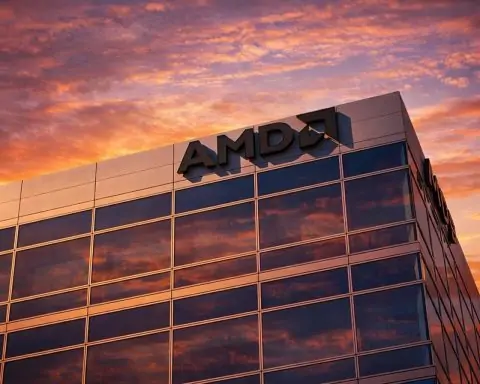- Nvidia (NVDA) – The AI chip leader’s stock is up ~60% year-over-year and recently hit record highs around $195 [1]. Nvidia’s data-center revenues are surging (+56% last quarter) as its GPUs fuel the generative AI boom [2]. Analysts see more upside – Loop Capital calls this the next “Golden Wave” of AI and raised its price target to ~$250 [3] [4].
- Microsoft (MSFT) – Shares trade near $514 (market cap ~$3.8 trillion) after a +23% gain over the past year [5]. The tech titan is pouring investment into AI across Azure cloud and OpenAI partnerships. Wall Street remains bullish: most analysts rate MSFT a “Buy,” with 12-month price targets ~20% above current levels (~$618) [6]. CEO Satya Nadella says we are in a “tectonic AI platform shift,” reorganizing Microsoft around AI services [7].
- Alphabet (Google, GOOGL) – Alphabet stock hit an all-time high around $256 this week, nearing a $3 trillion valuation [8]. It’s up over 30% year-to-date, outpacing the S&P 500 [9]. Google just unveiled $24 billion in new AI data centers and “AI everywhere” products (e.g. the Pixel 10 smartphone) [10]. Analysts are overwhelmingly positive: Morgan Stanley and BMO hiked targets to $270–$294, citing Google’s “AI leadership,” and one Oppenheimer analyst issued a Street-high $300 target [11].
- Advanced Micro Devices (AMD) – AMD has nearly doubled in 2025 [12], after scoring blockbuster AI chip deals. In early October, AMD signed multi-year agreements to supply next-gen GPUs to OpenAI (6 GW worth) and to Oracle (50,000 MI300 chips) [13] – contracts management says could yield “over $100 billion” in new revenue [14]. The stock spiked 34% in one day on the news, touching a record ~$239 [15]. Big banks now peg AMD’s value around $300/share (implying ~25% upside) [16]. However, AMD’s ~40× forward P/E ratio – even higher than Nvidia’s – means expectations are sky-high [17].
- Broadcom (AVGO) – This under-the-radar chip and software giant has surged ~70% YTD on the AI wave [18]. Broadcom’s latest earnings saw +22% YoY sales growth, handily beating forecasts, thanks to booming demand for its AI networking chips and enterprise software [19]. A new partnership to design 10 gigawatts of custom AI chips for OpenAI sent AVGO shares up 10% in one day [20]. The stock trades around $349 [21] with a rich >50× forward earnings multiple [22]. Even so, analysts remain bullish – targets range from $375 to $420 [23] – and some tout Broadcom as a potential “next $2 trillion” tech giant if AI momentum continues [24].
Nvidia (NVDA): The AI Chip Champion Driving the Boom
Nvidia has become synonymous with the AI revolution, thanks to its dominance in high-performance GPUs that power everything from advanced cloud computing to OpenAI’s ChatGPT. The company’s latest financials underscore its leadership: in the most recent quarter, Nvidia’s revenue soared 56% to $46.7 billion, fueled almost entirely by data-center AI chip sales [25]. As a result, Nvidia’s stock has been on fire – recently flirting with an all-time high near $195 per share in early October (about +58% from a year ago) [26]. This rally has pushed Nvidia’s market capitalization well past the $1 trillion milestone, solidifying it as one of the world’s most valuable tech companies.
Wall Street’s take: Nearly every analyst covering Nvidia rates it a Buy [27]. The consensus 12-month price targets now sit in the mid-$200s [28], signaling that experts see significant upside ahead despite the stock’s past gains. Loop Capital recently boosted its NVDA target to ~$250, citing a coming “Golden Wave” of generative AI adoption with Nvidia “at the front end” of surging demand [29] [30]. In other words, many believe Nvidia’s growth story is far from over. As one analyst enthused, “NVIDIA is at the front end of another leg of stronger-than-anticipated demand” [31] driven by AI, suggesting the company could continue delivering blockbuster results into 2026.
Investment metrics: Nvidia isn’t cheap – it trades around 35–40× forward earnings, reflecting enormous optimism in its growth [32]. Yet investors seem willing to pay a premium for its unparalleled position in AI chips. The company’s gross margins are fat (above 70%), and it’s translating the AI frenzy into real profits. Short-term, any slowdown in AI spending or new competition could spark volatility, but near-term momentum remains robust. With order books for Nvidia’s AI GPUs reportedly booked out well into next year, the supply-demand imbalance favors continued revenue jumps. The short- to medium-term outlook thus remains bullish: barring a broader market pullback, analysts see Nvidia extending its leadership in the AI hardware market, potentially justifying those lofty valuations [33]. Still, new entrants (like custom chips from startups or rival semiconductor firms) and macro risks urge some caution – even the hottest stock needs “breathing room” after such a run-up [34].
Microsoft (MSFT): Software Titan Transforming with AI
Microsoft has reasserted itself at tech’s cutting edge by aggressively infusing AI across its products and services. The stock sits around $514 (as of mid-October) – up roughly 23% year-over-year – pushing Microsoft’s market cap near an eye-popping $3.8 trillion [35]. This climb has been powered by the company’s “AI-first” strategy: its Azure cloud division is rolling out AI infrastructure and services at scale, it’s integrating OpenAI’s GPT models into offerings like GitHub Copilot and Office 365, and even revamping consumer products (Bing search, Windows Copilot) with generative AI. In the latest quarter, Microsoft’s revenue jumped +15% (to $281.7 billion annualized) with Azure cloud sales up 34% – clear evidence that AI is driving new growth [36].
Leadership & vision: CEO Satya Nadella recently declared, “We are in the midst of a tectonic AI platform shift”, emphasizing that Microsoft is reorganizing the company around AI innovation [37]. The tech giant has committed billions (including a reported $17.4 billion on Nvidia GPUs and cloud infrastructure) to ensure it remains at the forefront of this shift [38]. Microsoft’s partnership with OpenAI (in which it’s a major investor) gives it a unique edge in deploying advanced AI models. This has positioned Microsoft Azure as a key provider for enterprises looking to implement AI – from large language model services to custom AI solutions – effectively challenging Amazon’s AWS and Google Cloud in the AI arms race.
Analyst outlook: Sentiment on MSFT is overwhelmingly positive. “Almost all analysts” rate the stock a buy [39], thanks to Microsoft’s sturdy core businesses (Windows, Office, cloud) supercharged by new AI opportunities. Several investment banks have raised their price targets substantially in recent weeks – for instance, one group of analysts now projects Microsoft’s share price could reach about $618 within a year [40]. That implies roughly 20% upside from current levels. The optimism stems from expectations that AI features (like Microsoft 365 Copilot) will unlock new revenue streams and that Azure will continue winning cloud customers with its AI capabilities. Microsoft’s valuation, around 33× earnings, isn’t cheap, but it is supported by consistent double-digit growth and massive free cash flow. In the short to medium term, experts see Microsoft as a must-own for AI exposure: it’s a profitable, lower-risk way to invest in the AI trend without the volatility of smaller pure-play AI stocks.
Latest developments: Heading into late 2025, all eyes are on Microsoft’s product pipeline. The company is launching a unified “Copilot” AI assistant across Windows and Office this fall, aiming to put AI at the fingertips of a billion-plus users. Moreover, Microsoft’s Azure has inked high-profile deals to run AI workloads for firms like Meta and Adobe, showcasing its growing ecosystem. While regulatory scrutiny of Big Tech is a background risk (antitrust actions, etc.), Microsoft has largely stayed out of trouble compared to rivals. The bottom line is that Microsoft provides a balanced blend of AI-driven growth and blue-chip stability. Its short-term outlook is upbeat – strong earnings, new AI product rollouts, and positive analyst revisions – though investors should temper expectations as some AI hype is already baked in to that $3.8 trillion valuation [41].
Alphabet (GOOGL): Search and Cloud Giant Embracing the AI Era
Google’s parent company, Alphabet, is another AI powerhouse making big waves in 2025. Alphabet’s stock has climbed to record highs, closing around $256 on October 20 (a new all-time peak) [42]. At that price, Google flirts with a $3 trillion market cap, joining the exclusive club with Apple and Microsoft [43]. The shares have gained 30% year-to-date – far outperforming broader indices – as investors cheer Google’s AI moves and resilient core business [44]. Notably, even after this rally, many analysts argue the stock remains reasonably valued relative to peers, given Alphabet’s growth and profits [45].
AI initiatives: Alphabet has gone all-in on AI across its empire. In just the past month, Google announced over $24 billion in new AI infrastructure spending [46]. This includes building its largest-ever data center (a $15 billion AI super-center in India) and a $9 billion expansion of U.S. data centers [47] – a clear sign that Google is racing to meet exploding demand for AI computing power. On the product side, Google is integrating AI into virtually everything: it launched the Pixel 10 smartphone with an “AI everywhere” design, is rolling out AI features in Search (to fend off competition), expanding its Bard AI assistant, and offering new generative AI tools in Google Cloud. These moves underscore Alphabet’s determination to lead in AI, from foundational research (DeepMind’s innovations) to consumer gadgets [48].
Financial performance: Importantly, Google’s core businesses remain strong even as it invests in AI. Advertising, which still provides the bulk of revenue, has proven resilient – rebounding ~12% in Q2 despite concerns that AI chatbots could dent search ads [49]. Meanwhile, Google Cloud revenue jumped 32% last quarter and even turned profitable, reflecting growing enterprise adoption of Google’s AI/ML services [50]. Alphabet’s overall earnings are expected to rise ~27% this year on ~16% higher revenue [51] – robust for a company of its size [52]. This combination of solid fundamentals plus AI-driven growth has made Alphabet a favorite on Wall Street.
What experts say: The analyst community is overwhelmingly bullish on Alphabet. Over two dozen analysts rate the stock a Buy or Strong Buy, and even the few holdouts acknowledge Google’s strong position amid the AI boom [53]. Morgan Stanley recently bumped its price target from $210 to $270 [54], and BMO Capital Markets upped theirs to $294, explicitly citing Google’s “AI leadership” in search and cloud [55]. Perhaps most bullish, Oppenheimer gave Alphabet a Street-high $300 target – about 18% above the latest price – arguing Google is actually a better near-term bet than rival Meta Platforms thanks to its diverse AI opportunities [56]. “We are more bullish on [Alphabet] near term, given more conservative estimates and lower valuation,” an Oppenheimer analyst wrote, noting that even at record highs Google looks reasonably valued versus other tech giants in this AI frenzy [57].
That said, Alphabet isn’t without risks. Regulators globally continue to scrutinize Google’s dominance. On the bright side, a U.S. judge recently refused to break up Google’s core business in an ongoing antitrust case – a major relief that helped ignite Alphabet’s latest surge [58]. But new rules are looming: the U.K. just flagged Google Search as having “strategic market status,” foreshadowing tougher oversight [59], and the U.S. Supreme Court allowed an injunction that will force changes to Google’s app store policies by 2026 [60]. While none of these developments derail the short-term outlook for Alphabet, they add a layer of longer-term uncertainty. In the coming 1–2 years, however, the consensus is that AI will remain a growth catalyst for Google – bolstering its ad business with new products, driving cloud usage, and opening potential new revenue streams – keeping Alphabet as one of the top tech picks for investors riding the AI wave.
Advanced Micro Devices (AMD): Upstart Chipmaker Riding AI Wins
Long known as the runner-up to Intel in PC chips, AMD has reinvented itself as a major player in AI and data-center semiconductors. In 2025, AMD’s bold bets are paying off handsomely. The stock has exploded nearly +92% year-to-date [61], making it one of the market’s top performers. AMD recently notched game-changing deals that position it as a credible challenger to Nvidia in the AI chip arena. On October 6, AMD confirmed a multi-year agreement to supply 6 gigawatts of cutting-edge GPU capacity to OpenAI (creator of ChatGPT) – a massive order complemented by another deal to provide 50,000 MI300 AI accelerators to Oracle’s cloud [62]. These contracts could translate to “over $100 billion of new revenue over four years,” according to AMD’s own projections [63]. Investors responded with euphoria: AMD’s stock spiked 34% in a single day on the news, briefly touching a record high around $239 per share [64].
Why AMD is hot: In an AI-driven world hungry for chips, AMD is capitalizing on demand beyond just CPUs. Its MI300 series accelerators and GPUs are gaining traction as alternatives to Nvidia’s ubiquitous A100/H100 GPUs. Essentially, AMD is the prime “No. 2” option for any large cloud provider or AI startup that wants diversified suppliers (or missed out on Nvidia supply). With AI model training and deployment needs far outstripping current chip supply, AMD’s opportunity is enormous if it can execute. The company is also integrating AI into its traditional products – for example, new PC chips with AI co-processors – following what CEO Lisa Su calls a strategy to have “AI everywhere” in AMD’s portfolio.
Analyst sentiment: After years of playing second fiddle, AMD now has Wall Street’s full attention. Big-name analysts rushed to upgrade their forecasts following the OpenAI deal. Bank of America, Jefferies, and HSBC each hiked their price targets to about $300 per share [65], signaling belief that AMD’s AI wins will drive substantially higher earnings. Those targets imply roughly 25–30% upside from current levels [66]. The bullish thesis is that as AI investment surges, AMD’s revenues and profits could climb exponentially over the next 2–3 years. Indeed, AMD’s market value has already swelled above $350 billion (one of the world’s largest chip companies now, behind only Nvidia and a resurgent Intel) [67].
However, with great expectations comes great responsibility. AMD’s valuation looks stretched: the stock trades around 40× projected 2026 earnings, and well over 100× trailing earnings [68]. That multiple is even higher than Nvidia’s, highlighting how much future growth is already baked into AMD’s share price [69]. Bulls argue it’s justified by AMD’s newfound AI trajectory, but skeptics warn that any hiccup – a delay in chip rollout, competition from Intel’s upcoming GPUs, or stricter U.S. export controls on chips – could spark a sharp correction. Short-term, momentum is on AMD’s side as it begins shipping chips to OpenAI and other hyperscalers; the next few quarters could see revenue accelerate. Medium-term, analysts do expect robust growth (over 20% annual earnings growth) that might gradually bring the P/E down [70]. In sum, AMD offers higher risk and reward: it’s a top AI stock to buy for those who believe its best days lie ahead, but investors should “balance the euphoria with vigilance” as lofty valuations leave “little room for error” if execution falters [71].
Broadcom (AVGO): Under-the-Radar Giant Benefiting from AI Gold Rush
Rounding out our list is Broadcom, a company that may not have the same name recognition as Nvidia or Google, but which has become indispensable in the AI ecosystem. Broadcom’s stock has quietly rallied about +70% in 2025 [72], and for good reason: it straddles key parts of the tech stack – from networking chips to enterprise software – that are all being buoyed by the AI revolution. On the hardware side, Broadcom makes specialized ASICs, switches, and connectivity chips that large data centers need to handle AI workloads. For instance, its custom chips help shuttle data between the thousands of GPUs used in AI supercomputers. The boom in AI model training has meant booming orders for Broadcom’s high-end networking gear. At the same time, Broadcom is now also a software powerhouse (after its 2024 acquisition of VMware), providing cloud and virtualization software that many companies rely on (and which can be optimized for AI applications).
Recent performance: Broadcom’s latest quarterly results blew past expectations. In fiscal Q3 2025, the company reported $15.95 billion in revenue (up 22% year-on-year) and solid earnings of $1.69 per share (non-GAAP) [73]. Management explicitly credited surging AI-driven demand for its semiconductor division as a growth driver [74]. Perhaps the biggest vote of confidence came on October 13, when Broadcom announced a landmark partnership with OpenAI. Under this deal, Broadcom will design and supply 10 gigawatts worth of custom AI accelerator chips for OpenAI’s future data centers [75]. This is a huge project (10 GW is enough to power dozens of AI supercomputers) and signals that Broadcom’s chip design capabilities are world-class. The news sent AVGO shares up ~10% in one day [76], adding billions to its market cap. As of this week, Broadcom trades around $349 per share [77] – well above its levels a year ago, though still below some peer mega-caps in absolute size.
Analyst view and outlook: Despite its run, Broadcom continues to get love from analysts. JPMorgan recently reiterated an Overweight on AVGO with a price target around $400 [78], and other firms have set targets in the $375–$420 range [79]. The bullish case is that Broadcom has a unique one-two punch of critical hardware and software franchises, positioning it to keep riding the AI wave. In fact, some market commentators have even touted Broadcom as a candidate for the “next $2 trillion” company if it continues executing well [80]. That would mean roughly 6× growth from its current ~$350 billion market value – an ambitious scenario, but not impossible over a multi-year timeframe if AI-related sales truly explode.
However, Broadcom is not without risks. The stock’s valuation has expanded to over 50× forward earnings [81], richer than many chip peers, so any slowdown could hit the share price hard. Moreover, Broadcom faces a major pending regulatory hurdle: EU and U.S. regulators have scrutinized its acquisition of VMware (and other business practices), which could impose constraints or fines [82]. If the VMware integration doesn’t go smoothly or if competition in cloud software heats up, that could temper the growth outlook for the software division. In the short term, though, Broadcom’s pipeline looks strong – the OpenAI partnership and ongoing cloud spending on AI should keep revenue climbing into 2026. Broadcom’s diversification (chips and software) also gives it a bit more resilience if one segment faces headwinds. For investors seeking a slightly under-the-radar AI play with broad exposure, Broadcom offers a compelling mix of growth and stability, albeit at a premium price. Many on Wall Street still rate it a buy, but they also caution that at these heights, “stratospheric valuations” mean Broadcom must execute flawlessly to justify further gains [83].
Forecast & Investment Outlook: Early Innings of an AI Revolution
The big picture for these five AI-driven stocks – Nvidia, Microsoft, Alphabet, AMD, and Broadcom – is overwhelmingly positive as of late 2025. They are capitalizing on what Wedbush’s tech analyst Dan Ives dubs an “all-night party” in tech, with the AI boom “just getting started” [84]. In the short term (next 6–12 months), analysts largely expect continued strength. Most of these names have upward earnings momentum and rising analyst targets: for example, price goals about 15–30% above current levels are common across the group [85] [86], reflecting optimism that strong demand for AI products will persist into 2026. Companies like Nvidia and AMD are selling every AI chip they can make, Microsoft and Alphabet are rolling out monetized AI services, and Broadcom is booking long-term AI contracts – trends that should translate into robust revenue and profit growth over the coming quarters.
That said, investors should approach this AI frenzy with a dose of caution. A recent Bank of America survey found over half of fund managers now believe AI stocks are looking “frothy” or even in a bubble-like state [87]. We’ve seen valuations swell to historic highs: many of these top AI plays trade at 30×, 40×, even 50×+ earnings multiples [88]. Such stratospheric valuations leave little margin for error. If any of these companies deliver a disappointing quarter or if the growth of AI spending decelerates, the stocks could be in for sharp pullbacks. As one market strategist noted, even a red-hot rally “needs breathing room” eventually [89]. Risk factors like rising interest rates, tougher regulations, or a rotation out of tech could also temper the party.
Medium-term (1–3 years), however, the consensus is that we are still in the early innings of the AI revolution. The transformative potential of AI – across industries from healthcare to finance to consumer apps – suggests that demand for AI computing and software will remain elevated. These five companies are at the forefront of that trend, with dominant positions in their respective domains. As long as they continue to innovate and execute, they stand to benefit from secular tailwinds. For instance, cloud capex on AI is projected to grow exponentially (some estimates see hyperscalers doubling AI investment by 2026), which bodes well for chipmakers like Nvidia/AMD/Broadcom and platform providers like Microsoft/Google [90] [91].
In summary, the investment outlook for these AI leaders is strong but calls for selective confidence. Picking up shares of Nvidia, Microsoft, Alphabet, AMD, or Broadcom now could position investors to ride further gains as AI adoption accelerates. Each offers a different balance of risk/reward – from Microsoft and Google’s mega-cap stability to AMD’s high-growth potential. A diversified approach (holding a basket of top AI names) might be prudent to mitigate company-specific risks. The short-term ride may be volatile (as hype and reality jockey for position), but over the medium term, these stocks are backed by real earnings power and the platform-like dominance that can justify their valuations. As TS2’s market analysts put it, top picks like NVDA, AMD, AVGO (and others like CrowdStrike) are “priced for robust expansion – and analysts largely expect more gains” ahead [92]. Just remember that the higher these high-fliers climb, the more vigilantly one should monitor for any cracks in the narrative. For now, though, the road ahead for AI-focused investors still looks wide open and exciting, making these five stocks compelling buys going into 2026.
Sources: Key financial data and performance metrics from TS2.Tech and market reports [93] [94]; analyst forecasts and commentary from Reuters and TS2.Tech [95] [96]; quotes from industry experts and executives as cited above [97] [98]; recent news on company developments from TechStock² (ts2.tech) and related outlets [99] [100]. All information is current as of Oct. 22, 2025.
References
1. ts2.tech, 2. ts2.tech, 3. ts2.tech, 4. ts2.tech, 5. ts2.tech, 6. ts2.tech, 7. ts2.tech, 8. ts2.tech, 9. ts2.tech, 10. ts2.tech, 11. ts2.tech, 12. ts2.tech, 13. ts2.tech, 14. ts2.tech, 15. ts2.tech, 16. ts2.tech, 17. ts2.tech, 18. ts2.tech, 19. ts2.tech, 20. ts2.tech, 21. ts2.tech, 22. ts2.tech, 23. ts2.tech, 24. ts2.tech, 25. ts2.tech, 26. ts2.tech, 27. ts2.tech, 28. ts2.tech, 29. ts2.tech, 30. ts2.tech, 31. ts2.tech, 32. ts2.tech, 33. ts2.tech, 34. ts2.tech, 35. ts2.tech, 36. ts2.tech, 37. ts2.tech, 38. ts2.tech, 39. ts2.tech, 40. ts2.tech, 41. ts2.tech, 42. ts2.tech, 43. ts2.tech, 44. ts2.tech, 45. ts2.tech, 46. ts2.tech, 47. ts2.tech, 48. ts2.tech, 49. ts2.tech, 50. ts2.tech, 51. ts2.tech, 52. ts2.tech, 53. ts2.tech, 54. ts2.tech, 55. ts2.tech, 56. ts2.tech, 57. ts2.tech, 58. ts2.tech, 59. ts2.tech, 60. ts2.tech, 61. ts2.tech, 62. ts2.tech, 63. ts2.tech, 64. ts2.tech, 65. ts2.tech, 66. ts2.tech, 67. ts2.tech, 68. ts2.tech, 69. ts2.tech, 70. ts2.tech, 71. ts2.tech, 72. ts2.tech, 73. ts2.tech, 74. ts2.tech, 75. ts2.tech, 76. ts2.tech, 77. ts2.tech, 78. ts2.tech, 79. ts2.tech, 80. ts2.tech, 81. ts2.tech, 82. ts2.tech, 83. ts2.tech, 84. ts2.tech, 85. ts2.tech, 86. ts2.tech, 87. ts2.tech, 88. ts2.tech, 89. ts2.tech, 90. ts2.tech, 91. ts2.tech, 92. ts2.tech, 93. ts2.tech, 94. ts2.tech, 95. ts2.tech, 96. ts2.tech, 97. ts2.tech, 98. ts2.tech, 99. ts2.tech, 100. ts2.tech







